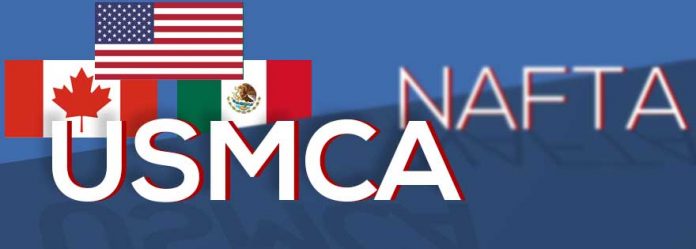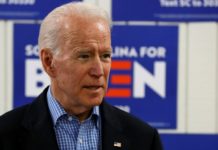
There’s a new U.S.-Mexico-Canada trade agreement after more than a year of high-stakes drama. President Trump’s fingerprints are all over the deal, announced Sept. 30, a renegotiation of the North American Free Trade Agreement (NAFTA), which took effect in 1994.
Trade deals typically aim to boost commerce among countries. What’s different about the U.S.-Mexico-Canada Agreement (USMCA)? Trump’s signature innovations showcase new attempts to make this type of deal result in less trade, not more. Here are four novel, trade-restricting elements:
1. New rules for how to make a (North) American car mean less trade in autos
The Trump administration demanded a new approach for how automakers in Mexico and Canada must build cars and trucks to continue selling to U.S. consumers without having to pay import tariffs. The USMCA tightened NAFTA’s already complex “rules of origin” — the requirements to qualify for the zero tariff — and mandated that even more parts be sourced from North America, even if the parts are costlier than those available elsewhere. And for the first time, a minimum amount of a car must be produced by workers earning above a certain wage.
[What is NAFTA, and what would happen to U.S. trade without it?]
Here’s what this means. The wage rule disincentivizes investment and production in Mexico, where pay scales are lower and production is less likely to qualify. This, by itself, is likely to reduce U.S. auto imports from Mexico.
But a second effect involves how these rules work to reduce auto exports to the rest of the world from Mexico, Canada and the United States. Constraining access to auto parts makes North American production costlier and the region’s cars less competitive. In Asia or Europe, automakers are not subject to Trump’s rules of origin.
2. Get ready for more auto tariff- and trade-related ripples
Higher costs also mean U.S. consumers will pay more for cars built in North America — and this could trigger more imports from Asia and Europe. But a surge in German-built Volkswagens and Japanese-assembled Nissans would seem likely to push Trump to follow through on his threats to raise tariffs on such vehicles from 2.5 to 20 or 25 percent. And the basic provisions of the USMCA do not protect carmakers in Mexico and Canada from the fallout of Trump imposing such tariffs.
Here’s why. Some companies may discover that satisfying Trump’s new wage and content rules is too costly and decide to assemble cars in Mexico and Canada that are “nonconforming” with those regulations. The Mexican government has estimated that 30 percent of current exports to the United States are nonconforming. For those cars, the tariff is the regular duty applied to other countries — such as in Europe or Japan — that do not have special trade deals with the United States.
Because Trump may increase that duty well above 2.5 percent, Mexico and Canada negotiated two distinct areas in the USMCA to try to shield cars being assembled in their markets from facing those tariffs. Each negotiated a side letter allowing exports at the lower rate if Trump imposes “national security” tariffs after completion of its ongoing investigation under Section 232 of the Trade Expansion Act of 1962. And Mexico negotiated a separate Annex 2-C to allow its cars continued access to the U.S. market if Trump raises the U.S. tariff above 2.5 percent for other reasons.
But Trump’s negotiators closed two additional loopholes that will limit such trade in the event that Trump increases this tariff. First, Mexico can access the 2.5 percent tariff only if it satisfies the original NAFTA rules for autos, including that 62.5 percent of the value of a car be made from North American parts. This means companies assembling in Mexico cannot import more engines or drivetrains from Asia or Europe to keep costs low. Second, the number of Mexican cars coming into the United States under this scenario is limited to 1.6 million units per year.
3. Canada will have to limit its dairy exports
At his USMCA Rose Garden remarks and news conference, Trump stated: “Dairy was a dealbreaker. And now for our farmers, it’s, as you know, substantially opened up much more.”
True, the deal gives U.S. farmers a bit more dairy access to the Canadian market. But the USMCA also introduced trade-restricting elements for three specific products: milk protein concentrates, skim milk powder and infant formula. In particular, Canada agreed to impose export taxes if its global exports reach a certain size.
[The U.S. filed a WTO dispute to save jobs — by increasing imports from China. Here’s why.]
Few countries ever agree to constrain use of their taxes on exports. One notable exception is China, but for the opposite reason. Under its WTO accession in 2001, the United States and other countries demanded that China agree to limit the use of export taxes for raw materials and rare earth metals. When China violated those terms, seeking to limit exports and keep these materials for Chinese producers, the United States challenged Beijing through formal WTO dispute channels.
But demanding that Canada impose export taxes effectively would limit, not encourage, its trade with the rest of the world. And the United States itself could not commit to imposing a U.S. export tax for any product — export taxes are forbidden under Article I, Section 9, of the U.S. Constitution.
4. No trade deals with China
Finally, Article 32.10 signals the consequences of negotiating a potential free-trade agreement with any nonmarket economies — that is a code word for “China.” The Trudeau government in particular has made overtures toward China as part of an attempt to diversify its imports and exports, partly in response to the uncertainty of the U.S.-Canada trade relationship triggered by Trump’s tariffs on steel and aluminum, as well as threats to rip up NAFTA and impose duties on autos.
[Trump has announced massive aluminum and steel tariffs. Here are 5 things you need to know.]
Under the USMCA, Canada would need to inform Trump three months before beginning to negotiate with China. And in the event that Canada and China reach a deal, Trump could terminate the USMCA with six months’ notice.
The anti-China clause may prove more symbolic than substantive, as Article 34.6already would allow any country to withdraw from the USMCA with six months’ notice, without requiring a justification. But the U.S. signal to its USMCA partners is clear: When it comes to China, it is either us or them.
Is Trump’s deal viable over the long term?
Despite Trump’s worldview on trade, trade agreements need to be a win-win economically to remain sustainable politically. The toxicity of these negotiations has left Canadian and Mexican politicians wary.
The new USMCA is not yet in place. National legislatures in all three countries must ratify the deal, and it is certain to face a vigorous debate in Congress.
And more surprises may arise even after the USMCA takes effect. If the trade-restricting elements of Trump’s deal turn out to be too problematic, it may be Canada or Mexico that is first to demand a sudden and costly renegotiation of Trump’s agreement.
Chad P. Bown is a senior fellow at the Peterson Institute for International Economics in Washington. With Soumaya Keynes, he hosts “Trade Talks,” a weekly podcast on the economics of international trade policy. Follow him on Twitter @ChadBown.






